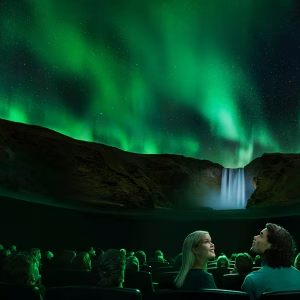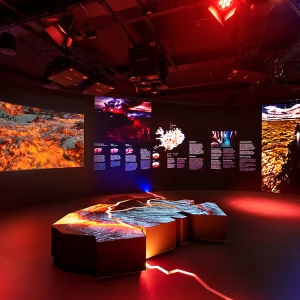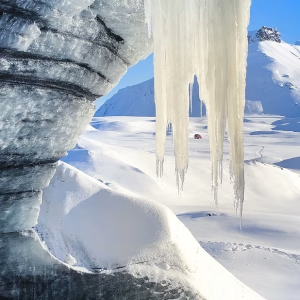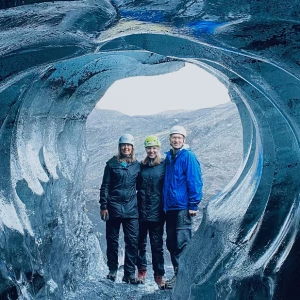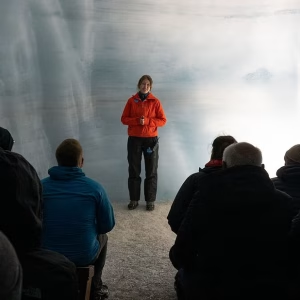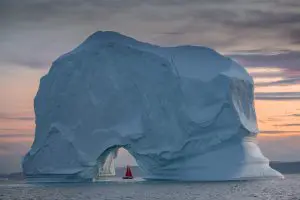Ice Cave Trips in Iceland
Check the Best Ice Cave Trips in Iceland
 We are not gonna hide: stepping inside an ice cave feels like entering another world. These natural formations are shaped by glacial rivers and the slow movement of ice, creating crystal-like chambers in shades of deep blue and turquoise that you will never forget.
We are not gonna hide: stepping inside an ice cave feels like entering another world. These natural formations are shaped by glacial rivers and the slow movement of ice, creating crystal-like chambers in shades of deep blue and turquoise that you will never forget.
Most ice cave tours are organized in winter when the ice is stable and safe to explore. The season usually runs from mid-November until March, though exact timing can change depending on the weather. The most famous locations for ice caves are in Vatnajökull National Park in the southeast, home to Europe’s largest glacier. There are also beautiful caves in the west and north, each with its own character and charm.
The journey to an ice cave is an adventure in itself. Local guides drive you across rugged landscapes in specially equipped vehicles before leading you on foot to the entrance. Inside, you can see layers of centuries-old ice, frozen air bubbles, and sweeping patterns carved by nature. The sound of distant water trickling through the glacier adds to the sense of wonder.
These natural formations change from year to year, sometimes even from week to week. A cave you visit one winter may not exist the next, which is why each trip feels so special and unique. It is also why going with an experienced guide is essential for safety and finding the most beautiful spots.
Photographers love ice cave tours for how light dances through the ice, but you do not need a camera to appreciate the beauty!
From Our Backyard: Insider Tips, Culture & Adventure
How We Will Create Your Lifetime Journey: Best Self-Drive Tours in Iceland and the Faroe Islands
Why Coolcations Are the Future of Travel: Iceland, the Faroe Islands, and Greenland Should Top Your List!
A Local’s Guide to Car Insurance in Iceland: What Every Traveler Should Know
Driving Iceland’s Ring Road: Everything You Need to Know Before You Go
Most Common Questions About Ice Cave Trips in Iceland
What are ice cave tours in Iceland?
Ice cave tours in Iceland are guided trips that take you inside glacier-formed caves, where you’ll explore stunning blue ice tunnels, crystal formations, and unique natural sculptures formed by centuries of glacial movement.
When is the best time to visit ice caves in Iceland?
The best time to visit natural ice caves in Iceland is during the winter months, from November to March, when the temperatures are cold enough to keep the caves stable and safe for exploration. Our winter self-drive tours in Iceland, which include the South Coast and Jökulsárlón glacier lagoon, offer ice cave tours as an optional choice or part of the package.
What's the difference between Katla Ice Cave and Crystal Ice Cave?
The Katla Ice Cave is accessible year-round and located beneath the Mýrdalsjökull glacier in Southern Iceland. The Crystal Ice Cave is a seasonal wonder located within the Vatnajökull glacier and is only accessible during the winter months.
Are ice cave tours in Iceland safe?
Yes, ice cave tours are led by professional glacier guides who continually monitor safety conditions. Caves are only entered when they are stable and secure and all necessary equipment is provided.
How cold is it inside an Icelandic ice cave?
Temperatures inside the caves typically range from 0°C to -5°C (32°F to 23°F). While not freezing cold, it’s important to dress warmly in layers and wear waterproof outerwear and sturdy hiking boots.
Do I need special gear for an ice cave tour in Iceland?
Tour operators provide crampons, helmets, and headlamps. You’ll need to bring your own warm layers, gloves, hat, and waterproof boots suitable for icy terrain.
Can I visit ice caves without a guide?
No. Due to the unpredictable and dangerous nature of glaciers, visiting ice caves without a certified guide is highly unsafe and strongly discouraged. Guided tours are the only responsible way to explore them.
How long do ice cave tours in Iceland last?
Most ice cave excursions last between 2 to 5 hours, depending on the location and access. Some tours also include glacier hiking or super jeep transportation to the cave site.
What is the Crystal Ice Cave, and why is it famous?
The Crystal Ice Cave, located in Vatnajökull National Park, is known for its deep blue ice and stunning, translucent walls. It’s one of Iceland’s most photographed natural ice caves and only appears in winter.
Are there ice caves near Reykjavík?
While there are no natural ice caves located in Reykjavík, Katla Ice Cave, situated near Vík in Southern Iceland, is one of the closest accessible options, approximately a 2.5-hour drive from the capital.
Is the Langjökull ice tunnel a real ice cave?
The Langjökull ice tunnel is a man-made attraction carved deep into Iceland’s second-largest glacier. While not naturally formed, it offers a unique chance to walk inside a glacier year-round.
Can children join ice cave tours in Iceland?
Yes, many tours are suitable for families with children, typically from the age of 8 and up, depending on the tour’s difficulty and accessibility. Always check age restrictions and physical requirements before booking.
What should I wear on an Iceland ice cave trip?
Wear thermal base layers, fleece or wool mid-layers, a waterproof jacket and pants, warm gloves, and insulated boots. Icelandic weather is unpredictable, even inside the caves.
Can I take photos inside the ice caves?
Absolutely! Photography is encouraged, and the ice caves offer some of the most photogenic landscapes in Iceland. Just remember to be mindful of the group and avoid blocking narrow passages while shooting.



